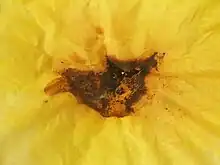 | |
 | |
| Names | |
|---|---|
| IUPAC name
Nickel(II) chromate | |
| Other names
nickelous chromate nickel chromate nickel(II) chromium(VI) oxide | |
| Identifiers | |
3D model (JSmol) |
|
| ChemSpider | |
| ECHA InfoCard | 100.035.227 |
| EC Number |
|
PubChem CID |
|
| |
| |
| Properties | |
| NiCrO4 | |
| Molar mass | 174.71 g/mol |
| Appearance | dark maroon-colored powder |
| very slightly soluble in water[1] | |
| Solubility | soluble in hydrochloric acid |
| Hazards | |
| Flash point | Non-flammable |
| Related compounds | |
Other anions |
nickel(II) molybdate nickel(II) tungstate |
Other cations |
magnesium chromate cadmium chromate |
Except where otherwise noted, data are given for materials in their standard state (at 25 °C [77 °F], 100 kPa).
Infobox references | |
Nickel(II) chromate (NiCrO4) is an acid-soluble compound, red-brown in color, with high tolerances for heat. It and the ions that compose it have been linked to tumor formation and gene mutation, particularly to wildlife.[2]
Synthesis
Nickel(II) chromate can be formed in the lab by heating a mixture of chromium(III) oxide and nickel oxide at between 700 °C and 800 °C under oxygen at 1000 atm pressure. It can be produced at 535 °C and 7.3 bar oxygen, but the reaction takes days to complete.[3] If the pressure is too low or temperature too high but above 660 °C, then the nickel chromium spinel NiCr2O4 forms instead.[3]
Karin Brandt also claimed to make nickel chromate using a hydrothermal technique.[4][5]
Precipitates of Ni2+ ions with chromate produce a brown substance that contains water.[6]
Properties
The structure of nickel chromate is the same as for chromium vanadate, CrVO4. Crystals have an orthorhombic structure with unit cell sizes a = 5.482 Å, b = 8.237 Å, c = 6.147 Å. The cell volume is 277.6 Å3 with four formula per unit cell.[5][7]
Nickel chromate is dark in colour, unlike most other chromates which are yellow.[3] The infrared spectrum of nickel chromate show two sets of absorption bands. The first includes lines at 925, 825, and 800 cm−1 due to Cr-O stretching, and the second has lines at 430, 395, 365 (very weak) due to Cr-O rock and bend and 310 cm−1 produced from Ni-O stretching.[8]
Reaction
When heated at lower oxygen pressure around 600 °C, nickel chromate decomposes to the nickel chromite spinel, nickel oxide and oxygen.[3]
- 4 NiCrO4 → 2 NiCr2O4 + 2 NiO + 3 O2 (gas)
Related
Nickel chromates can also crystallize with ligands. For instance, with 1,10-phenanthroline it can form triclinic olive-colored crystals of [Ni(1,10-phenanthroline)CrO4•3H2O]•H2O, orange crystals of Ni(1,10-phenanthroline)3Cr2O7•3H2O, and yellow powdered Ni(1,10-phenanthroline)3Cr2O7•8H2O.[6]
References
- ↑ Perry, Dale L. (19 April 2016). Handbook of Inorganic Compounds, Second Edition. CRC Press. p. 290. ISBN 9781439814628.
- ↑ Eisler, R. (1998). Nickel Hazards to Fish, Wildlife, and Invertebrates: a Synoptic Review. Laurel: U.S. Geological Survey
- 1 2 3 4 Muller, Olaf; Roy, Rustum; White, William B. (December 1968). "Phase Equilibria in the Systems NiO-Cr2,O3,-O2, MgO-Cr2O3-O2, and CdO-Cr2,O3,-O2, at High Oxygen Pressures". Journal of the American Ceramic Society. 51 (12): 693–699. doi:10.1111/j.1151-2916.1968.tb15930.x.
- ↑ Brandt, Karin (1943). "X-Ray Analysis of CrVO4 and isomorphous compounds". Arkiv för Kemi, Mineralogi och Geologi. 17A (6): 1–13. (not consulted)
- 1 2 Muller, Olaf; White, William B.; Roy, Rustum (September 1969). "X-ray diffraction study of the chromates of nickel, magnesium and cadmium". Zeitschrift für Kristallographie. 130 (1–6): 112–120. Bibcode:1969ZK....130..112M. doi:10.1524/zkri.1969.130.1-6.112.
- 1 2 Bronowska, W; Staszak, Z; Daszkiewicz, M; Cieślak-Golonka, M; Wojciechowska, A (May 2002). "Systematic investigation of the [Ni2+–phen–CrO42−] system; dichromate species isolated from alkaline solutions". Polyhedron. 21 (9–10): 997–1003. doi:10.1016/S0277-5387(02)00912-9.
- ↑ Baran, E. J (May 1998). "Materials belonging to the CrVO4 structure type: preparation, crystal chemistry and physicochemical properties". Journal of Materials Science. 33 (10): 2479–2497. Bibcode:1998JMatS..33.2479B. doi:10.1023/A:1004380530309. S2CID 97516785.
- ↑ Muller, Olaf; White, William B.; Roy, Rustum (August 1969). "Infrared spectra of the chromates of magnesium, nickel and cadmium". Spectrochimica Acta Part A: Molecular Spectroscopy. 25 (8): 1491–1499. Bibcode:1969AcSpA..25.1491M. doi:10.1016/0584-8539(69)80133-9.